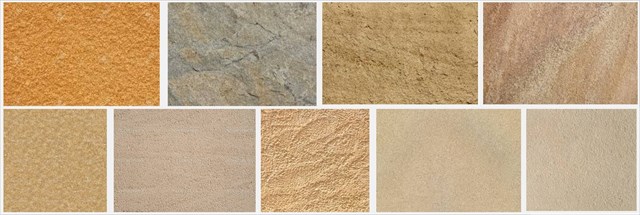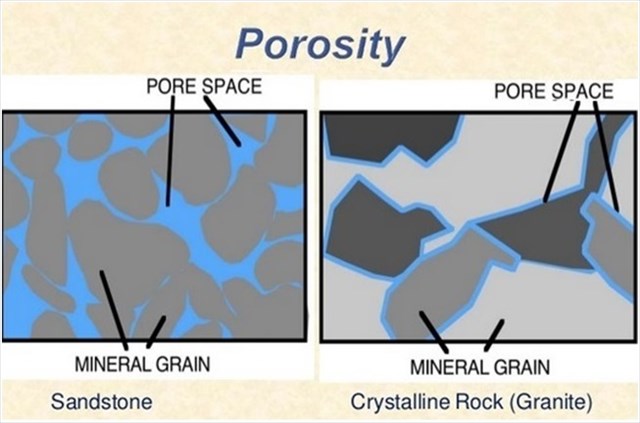Rubislaw (Kirk) Parish Church

Rubislaw Parish Church was built in 1875. built in sandstone (because, apparently, granite was too expensive).
Rubislaw Parish Church is particularly unusual in that it is constructed of sandstone not granite, like the majority of churches in Aberdeen. George Washington Wilson was supposedly willing to cover the cost of the granite, but his offer came too late, as the contract had already been let.
In 1961 a Church Centre was built nearby.
The Parish of Rubislaw is bounded by Queen's Road to the south, King's Gate to the north, Fountainhall Road to the east and Anderson Drive to the west. Rubislaw Church is at the corner of Queen's Gardens and Fountainhall Road, at the roundabout with the statue of Queen Victoria.

Sandstone
What sort and type of stone is that?
Sandstone is created from sand that has been cemented together to make a rock. It forms wherever sand is buried under the right conditions to pack it into a solid rock. This often occurs in offshore river deltas; however, sandstone is also found in desert dunes and on beaches.
Sandstone is a (clastic)* sedimentary rock because it is formed from sediments. *Clastic sedimentary rocks form by weathering processes which break down rocks into pebble, sand, clay and pieces of minerals and fragment particle that is exposed to wind, ice, and water. Clastic and nonclastic sedimentary rocks are the only members of the rock family that contain fossils as well as indicators of the climate (ripple marks, mudcracks and raindrops) that was present when the rock was formed.
Clastic sedimentary rocks are named according to the grain size of the sediment particles.
Conglomerate = coarse (64 mm to >256 mm), rounded grains
Breccia = coarse (2mm to 64 mm), angular grains
Sandstone = grains ranging in size from 2mm to 1/16 mm
Shale = grains ranging in size from 1/16 mm to nothing
Sandstone usually contains a large amount of sand, but there are instances in which sandstones contain other materials that are fine and coarse. Matrix and cement are also found in sandstone. The matrix is created by the fine-grained particles in the sand. The cement acts as the binding force and is found in the minerals that get into the sand. These minerals bind the sediments into the rock. The cement in sandstone is usually made from quartz, iron oxide or calcium carbonate. Sandstone that contains a lot of matrix is considered poorly sorted. Well-sorted sandstone contains a small amount of matrix and is called arenite. The mix of matrix and cement is what gives sandstone its color. Since many kinds of minerals can make up sandstone, it is found in several different colors.
Sandstone color

Sandstone forms over the course of centuries, as deposits of sand accumulate in rivers, lakes or on the ocean floor, and the sand blends with calcite or quartz and then undergoes compression. After enough time goes by, the pressure pushes elements or/and minerals together to create sandstone. Because not all sand is identical but instead comes in a variety of colors and grain textures, each formation has a unique appearance.
Because it is composed of light colored minerals, sandstone isn`t typically any color. It depends on the minerals that the grains are composed of in the combination with the cementing minerals / elements. Bright red in devon, dark green in dorset and kent, etc. Other elements, however, create colors in the sandstone. The most common sandstones have various shades of red, caused by iron oxide (rust). In some instances, there is a purple hue caused by manganese.
What is Sandstone, and is it a hard type of stone?
- Porosity and Permeability -
To a geologist the word "sand" in sandstone refers to the particle size of the grains in the rock rather than the material of which it is composed. Sand-size particles range in size from 1/16 millimeter to 2 millimeters in diameter. Sandstones are rocks composed primarily of sand grains.

Sandstone is hard and strong enough to be used regularly in cut stone construction, but it is compressive and tensile strengths vary depending on the grade of the sandstone and the type of force or pressure applied. It is also used regularly in road building in crushed form.
Sandstone is, in geological terms, an aquifer. It is a porous stone that holds a great deal of water. It occurs in a large variety of grades including bluestone, quartzose sandstone and arkosic sandstone, which is rich in feldspar. These grades are variously durable and serve a number of discrete purposes.
Sandstone has, on average, a specific gravity of 2.2 as compared to an equal volume of water. It has a mass density of 4,850 pounds per cubic feet. This makes it ideally suited for use in large-scale construction where its relative lightness and durability enable ease of transport and a long effective lifespan.
Sandstone is lithified sand compacted over a period of centuries by tidal forces and gravity's pull. This process transforms it from loose, wet sand into dense stone which can be used in a variety of commercial and architectural enterprises. Broken down, sandstone is very useful in the construction of highways where a strong stone that can hold its form once broken and set is needed.
Porosity and permeability are related properties of any rock or loose sediment. Sandstone rocks usually have high porosity, and are usually “high perm.
- Porosity consists of the tiny spaces in the rock that can hold, water, air or petroleum.
- Permeability is a characteristic that allows, water, air and petroleum to flow through the rock.
Porosity
Porosity of a rock is a measure of its ability to hold a fluid. Mathematically, porosity is the open space in a rock divided by the total rock volume (solid + space or holes). Porosity is normally expressed as a percentage of the total rock which is taken up by pore space. For example, a sandstone may have 8% porosity. This means 92% is solid rock and 8% is open space containing petroleum, air or water.
Even though sandstone is hard, and appears very solid, it is really very much like a sponge (a very hard, incompressible sponge). Between the grains of sand, enough space exists to trap fluids! The holes in sandstone are called porosity, from the word “porous”.
To log this cache.
To get to log this cache you will have to read the cache text and visit the coordinates given. After that you will have to answer the questions which are related to the text and the coordinates given.
When answers are collected, send them to CO for verification. I will accept answers sent via email or through the Message Centre.
As I own about 50 earthcaches there are MANY mails/messages to answer back on, and I will not always be able to answer right-back, BUT I READ ALL SENT ANSWERS AND LOGS, so if anything is not correct or need an upgrade, you will indeed hear back from me.
Thanks for your understanding, and for picking one of my caches.
You can log immediately after answers are sent the CO. If there are any questions about your answers CO will contact you.
Logs without answers to CO or with pending questions from CO will be deleted without any further notice.
Please do not include pictures in your log that may answer the questions.
Questions
1. Answer the questions by reading the cache text and visiting the cache coordinates!
A. Go to the given coordinates, what type of stone do you find on this spot? (Use the photo under)

B. Describe the stone you have in front of you: What are the characteristics and structure of it and what is this caused of? Measure the size of the layers, what would you say is the approx distance between the layers if there is any? And what color is the stone, and why?
C. Have a look at the wall! Is it filled with fossils from its period of formation?
D. Sedimentary rocks are often deposited in layers, and the stone can come in different colors. By having a look at the stone at gz (from half the door height and down, and half the door height and above approx), do you see any difference in color in the stone? Explain what you see, and try tell why there is a difference?
2. It’s voluntary to post a photo in your online log. Without revealing any answers!
**************************************
For full information on how you can expand the Church Micro series by
sadexploration
please read the Place your own Church Micro page before you contact him at churchmicro.co.uk
See also the Church Micro
Statistics and Home pages for further information about the series.
*************************************
